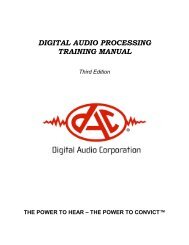QuickEnhance® VST User's Manual - Digital Audio Corporation
QuickEnhance® VST User's Manual - Digital Audio Corporation
QuickEnhance® VST User's Manual - Digital Audio Corporation
Create successful ePaper yourself
Turn your PDF publications into a flip-book with our unique Google optimized e-Paper software.
5.4.2 Cassette tapes<br />
Cassette recorders are still the mainstay of law enforcement audio<br />
recording. There are many good-quality units available. Again, the builtin<br />
microphone should be used only as a last resort. These recorders<br />
have bandwidths to 10,000 Hz, which is more than adequate for<br />
recording voice. The highest recordable frequency is determined by two<br />
principal factors, tape speed and head gap. The faster the speed and the<br />
narrower the gap, the higher the recordable bandwidth. Many recorders<br />
have been modified to reduce the speed by one-half in order to allow<br />
twice as much time to be recorded onto tape. You do not get something<br />
for nothing: changing design speeds results in reducing the highest<br />
potentially recordable frequency to lower than the desirable 5000 Hz.<br />
Another problem with analog magnetic tape players is dynamic frequency<br />
variations referred to as wow and flutter. These effects are due to the<br />
tape’s passing over the record/playback head at a varying speed. Motor<br />
speed regulation, varying tape tension, and irregularities in pinch and<br />
backup roller shape all contribute. Wow is a low frequency variation (a<br />
few Hz), while flutter is a high frequency variation (up to hundreds of Hz).<br />
Wow and flutter are generated during both the recording and the<br />
playback processes. The overall effect of the fluctuations is to produce<br />
an undesired “modulation” effect on the recorded audio. Substantial<br />
wow and flutter are audible as a vibrating, or nervous, overtone to the<br />
voice, accompanied by a loss of audio crispness. Even modest levels of<br />
wow and flutter impair clarification and noise cancellation because the<br />
signal processor is forced to “chase” the noise.<br />
Although it is not always possible, tape playback should be done on the<br />
same machine that did the recording. This can help minimize some of<br />
the deficiencies of the specific recording equipment .<br />
5.4.3 <strong>Digital</strong> recorders<br />
<strong>Digital</strong> recorders (e.g., DATs, MiniDiscs, recordable CDs, and SSABRs)<br />
are becoming more popular as their price decreases. These recording<br />
units offer exceptional quality for audio reproducibility. The incoming<br />
analog signal is converted into a sequence of numbers in an analog-todigital<br />
(A/D) converter. The audio is sampled at rates up to 48,000<br />
samples per second (and beyond) to define the signal precisely, with no<br />
introduction of wow or flutter distortion. These samples are stored as<br />
binary numbers (1 or 0). The data can be recorded onto magnetic tapes,<br />
floppy disks, hard disks, compact discs, DVDs, or flash memory chips.<br />
Using a laser, the data can be optically recorded. Even if the recorded<br />
data has very poor noise characteristics, it is still possible to distinguish<br />
between 1 and 0 to achieve a good quality playback.<br />
20
















